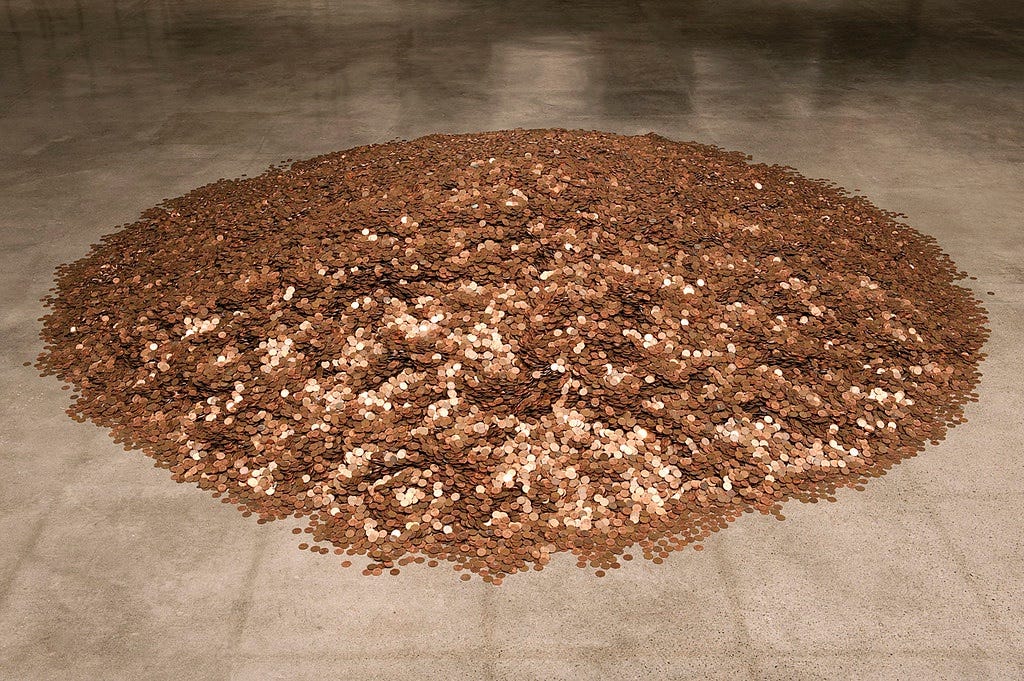Charlatanism; Deception
Reservations Recommended, Chapter 4:
Throughout the session, we had the feeling that the company had been bilked by a charlatan in a rumpled tweed jacket. […]
Online Etymological Dictionary:
charlatan (n.) “one who pretends to knowledge, skill, importance, etc.,” 1610s, from French charlatan “mountebank, babbler” (16c.), from Italian ciarlatano “a quack,” from ciarlare “to prate, babble,” from ciarla “chat, prattle,” which is perhaps imitative of ducks’ quacking. Related: charlatanical.
Art: Conceptual; Art: Commodification of
Reservations Recommended, Chapter 4:
Upon emerging from the session, however, we were astonished to find that as a result of the training we had received in perceiving a mound of sand as individual grains, we were able to perceive the staggering fee the company had paid this tweedy fellow as individual dollar bills! […] It may take a great deal of company time for practice, but we think that eventually we will be able to perceive the fee as individual pennies, and then we will know that each and every one of them was money well spent.
Let’s suppose that the “staggering fee” that the company paid the “tweedy fellow” was ten thousand dollars (in 1990 dollars, since the first edition of Reservations Recommended was published in 1990). Ten thousand dollars would be a million pennies. Here are a million pennies in a mound:

Dennis Young, “Speculate to Appreciate”:
The work […] invites pondering in purely formal terms: its aggregate of spectacular colours, its shape conditioned by natural forces, its six thousand pounds of weightiness and the astronomical number of subtle variants that its mode of fabrication can engender, while it quite literally erodes the notion of integrity of form by inviting people to throw pennies onto it or to sneak some away from it—a volatility which nevertheless lies beneath our threshold of perception. But the work is more than these matters of form, for by a process of caricature it too addresses some of the factors that contribute to the commodification of art.
In this respect, One Million Pennies is not only a coup de théatre, for it seems to be the one work that it is possible to make which conspicuously rejects the conditions of authenticity, uniqueness and scarcity necessary for a work of art to be relevant to a theory of commodities, while at the same time declaring an identity, like Five Grams of Gold, as both a commodity on the metals market and a token of all commodities in the profane world. The prescription for the piece, in the Glenbow Museum folder, aims at multiple ironies. It declares the work to be “one million pennies piled in the middle of a room” (though later it equivocates about this), and names a price for it of $10,000, implying absolute equity for the buyer and zero profit for the artist. Later it equivocates about this too, in an attempt to persuade a prospective buyer to pay the artist $10,000 and compensate him for the million pennies once their equivalent has been raised by investing their sum in a bank! We gather from this that the piece materializes and dematerializes according to need—spending most of the time in a dematerialized state, “stored” in a bank from which it might even be put into circulation and irretrievably scattered in its material form though conceptually capable of being re-integrated so long as the bank is prepared to recognize a difference between the token value of coins and the token value of bills (though, caveat emptor, this difference may not be recognized).
See also:
Deception TG 91
Art, Play TG 5; Paint-by-Numbers TG 107, TG 108; Necessity of Transformation in TG 110; Doodling TG 165; Art Materials: Masonite TG 167; Art and Craft and Real Life TG 385; Art: Literature: Responding to: Sharing the Experience TG 367
Have you missed an episode or two or several?
You can begin reading at the beginning or you can catch up by visiting the archive or consulting the index to the Topical Guide.
You can listen to the episodes on the Personal History podcast. Begin at the beginning or scroll through the episodes to find what you’ve missed.
You can listen to “My Mother Takes a Tumble” and “Do Clams Bite?” complete and uninterrupted as audiobooks through YouTube.
You can ensure that you never miss a future issue by getting a free subscription. (You can help support the work by choosing a paid subscription instead.)
At Apple Books you can download free eBooks of Little Follies and Herb ’n’ Lorna.
You’ll find overviews of the entire work in An Introduction to The Personal History, Adventures, Experiences & Observations of Peter Leroy (a pdf document) and at Encyclopedia.com.


